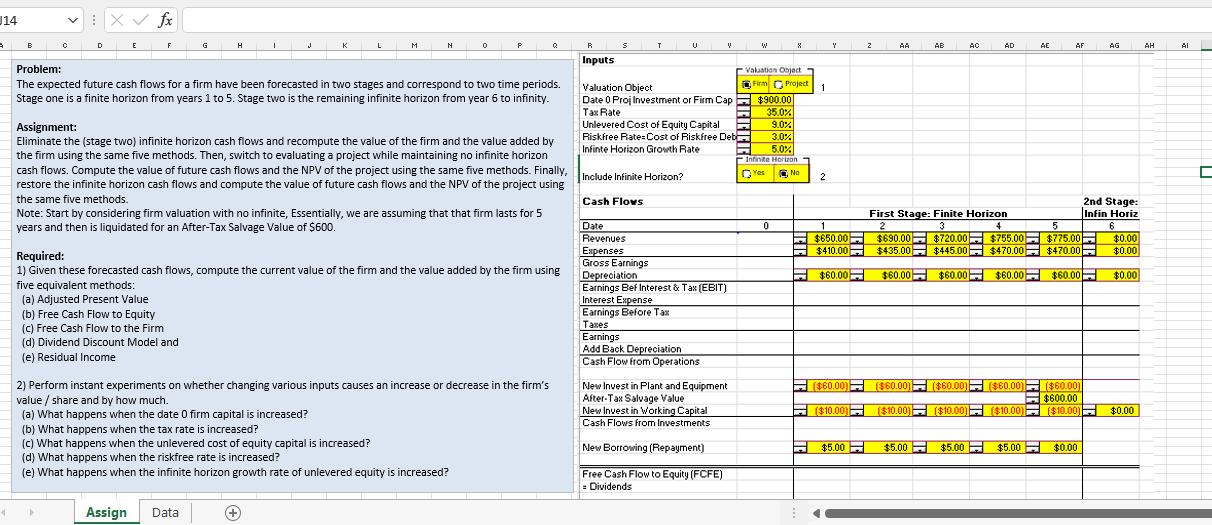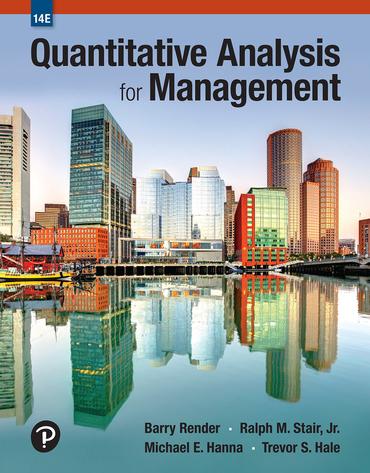
B C D E F G H K L M N 0 P Q R T U V w X Y Z AA AB AC AD AE AF AG AH AI - 1 OTTUTTEITA 014 X fx S S Inputs Problem: Valuation Object The expected future cash flows for a firm have been forecasted in two stages and correspond to two time periods. Valuation Object Firm Project Stage one is a finite horizon from years 1 to 5. Stage two is the remaining infinite horizon from year 6 to infinity. Date 0 Proj Investment or Firm Cap $900.00 Tax Rate 35.0% Assignment: Unlevered Cost of Equity Capital 9.0% Eliminate the (stage two) infinite horizon cash flows and recompute the value of the firm and the value added by Riskfree Rate:Cost of Riskfree Debu 3.0% Infinte Horizon Growth Rate 5.0% the firm using the same five methods. Then, switch to evaluating a project while maintaining no infinite horizon Infinite Horizon cash flows. Compute the value of future cash flows and the NPV of the project using the same five methods. Finally, Include Infinite Horizon? Yes Na 2 restore the infinite horizon cash flows and compute the value of future cash flows and the NPV of the project using the same five methods. Cash Flows 2nd Stage: Note: Start by considering firm valuation with no infinite, Essentially, we are assuming that that firm lasts for 5 First Stage: Finite Horizon Infin Horiz years and then is liquidated for an After-Tax Salvage Value of $600. Date 0 2 3 4 5 6 Revenues $650.00 $690.00 $720.00 - $755.00 $775.00 $ $0.00 Expenses $410.00 $435.00 $445.00 $470.00 $470.00 Required: Gross Earnings 1) Given these forecasted cash flows, compute the current value of the firm and the value added by the firm using Depreciation $60.00 $ $60.00 $60.00 $60.00 $60,00 $ $0.00 five equivalent methods: Earnings Bef Interest & Tax (EBIT) (a) Adjusted Present Value Interest Expense (b) Free Cash Flow to Equity b Earnings Before Tax (c) Free Cash Flow to the Firm Taxes (d) Dividend Discount Model and Earnings d Add Back Depreciation (e) Residual Income Cash Flow from Operations 2) Perform instant experiments on whether changing various inputs causes an increase or decrease in the firm's New Invest in Plant and Equipment ( ($60.00 ($60.00 ($60.00) ($60.00 ($60.00) () ($ value / share and by how much. After-Tax Salvage Value $600,00 (a) What happens when the date 0 firm capital is increased? New Invest in Working Capital ($10.00) ($10.00) $10.00) ($10.00) $10.00 $0.00 ( ( () (b) What happens when the tax rate is increased? Cash Flows from Investments (c) What happens when the unlevered cost of equity capital is increased? New Borrowing (Repayment) $5.00 $5.00 - $5.00 - $5.00 $0.00 (d) What happens when the riskfree rate is increased? (e) What happens when the infinite horizon growth rate of unlevered equity is increased? Free Cash Flow to Equity (FCFE) Dividends $0.00 Assign Data + B C D E F G H K L M N 0 P Q R T U V w X Y Z AA AB AC AD AE AF AG AH AI - 1 OTTUTTEITA 014 X fx S S Inputs Problem: Valuation Object The expected future cash flows for a firm have been forecasted in two stages and correspond to two time periods. Valuation Object Firm Project Stage one is a finite horizon from years 1 to 5. Stage two is the remaining infinite horizon from year 6 to infinity. Date 0 Proj Investment or Firm Cap $900.00 Tax Rate 35.0% Assignment: Unlevered Cost of Equity Capital 9.0% Eliminate the (stage two) infinite horizon cash flows and recompute the value of the firm and the value added by Riskfree Rate:Cost of Riskfree Debu 3.0% Infinte Horizon Growth Rate 5.0% the firm using the same five methods. Then, switch to evaluating a project while maintaining no infinite horizon Infinite Horizon cash flows. Compute the value of future cash flows and the NPV of the project using the same five methods. Finally, Include Infinite Horizon? Yes Na 2 restore the infinite horizon cash flows and compute the value of future cash flows and the NPV of the project using the same five methods. Cash Flows 2nd Stage: Note: Start by considering firm valuation with no infinite, Essentially, we are assuming that that firm lasts for 5 First Stage: Finite Horizon Infin Horiz years and then is liquidated for an After-Tax Salvage Value of $600. Date 0 2 3 4 5 6 Revenues $650.00 $690.00 $720.00 - $755.00 $775.00 $ $0.00 Expenses $410.00 $435.00 $445.00 $470.00 $470.00 Required: Gross Earnings 1) Given these forecasted cash flows, compute the current value of the firm and the value added by the firm using Depreciation $60.00 $ $60.00 $60.00 $60.00 $60,00 $ $0.00 five equivalent methods: Earnings Bef Interest & Tax (EBIT) (a) Adjusted Present Value Interest Expense (b) Free Cash Flow to Equity b Earnings Before Tax (c) Free Cash Flow to the Firm Taxes (d) Dividend Discount Model and Earnings d Add Back Depreciation (e) Residual Income Cash Flow from Operations 2) Perform instant experiments on whether changing various inputs causes an increase or decrease in the firm's New Invest in Plant and Equipment ( ($60.00 ($60.00 ($60.00) ($60.00 ($60.00) () ($ value / share and by how much. After-Tax Salvage Value $600,00 (a) What happens when the date 0 firm capital is increased? New Invest in Working Capital ($10.00) ($10.00) $10.00) ($10.00) $10.00 $0.00 ( ( () (b) What happens when the tax rate is increased? Cash Flows from Investments (c) What happens when the unlevered cost of equity capital is increased? New Borrowing (Repayment) $5.00 $5.00 - $5.00 - $5.00 $0.00 (d) What happens when the riskfree rate is increased? (e) What happens when the infinite horizon growth rate of unlevered equity is increased? Free Cash Flow to Equity (FCFE) Dividends $0.00 Assign Data +







